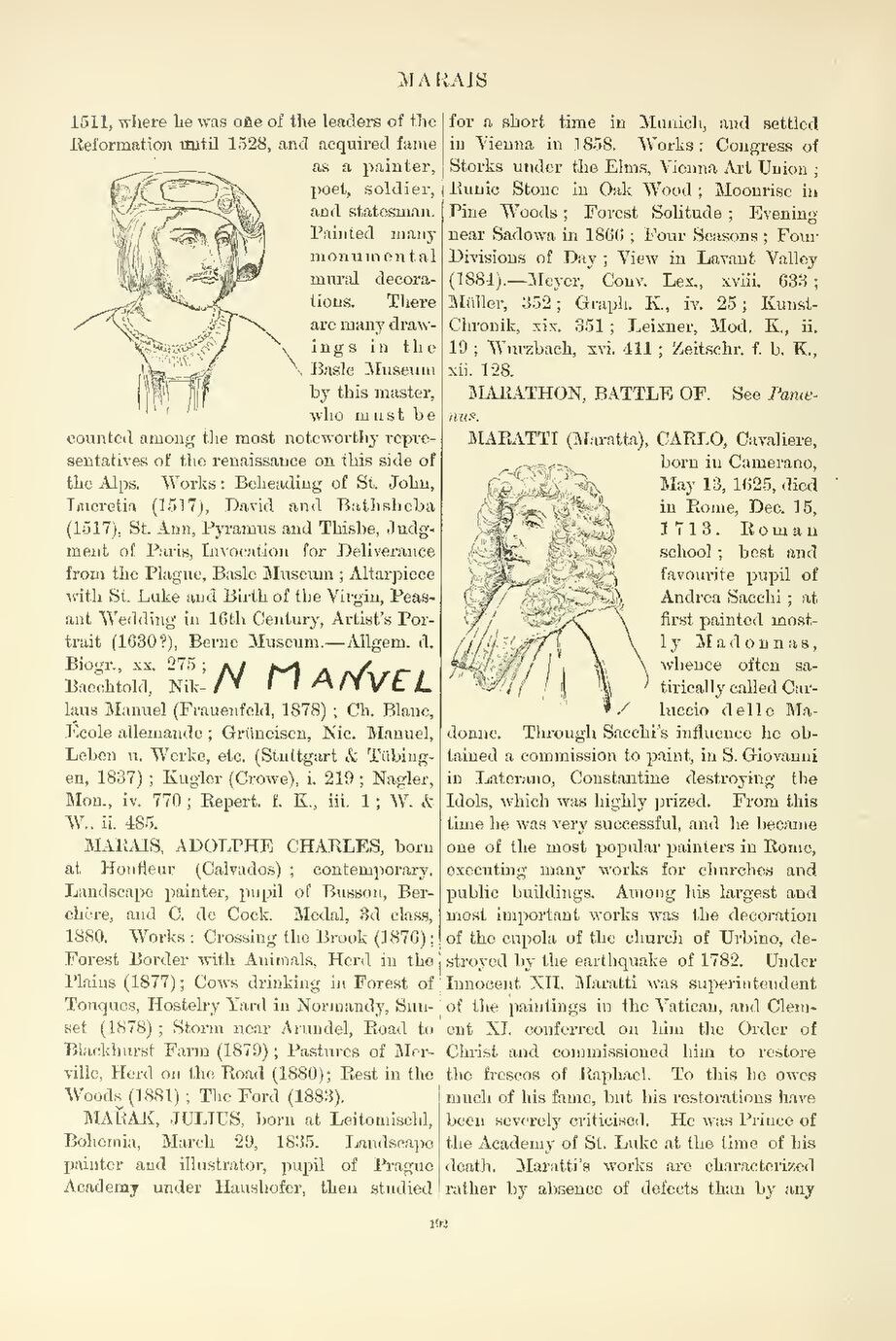An image should appear at this position in the text. To use the entire page scan as a placeholder, edit this page and replace "{{missing image}}" with "{{raw image|Cyclopedia of painters and paintings (IA cyclopediaofpain03cham).pdf/214}}". Otherwise, if you are able to provide the image then please do so. For guidance, see Wikisource:Image guidelines and Help:Adding images. |
An image should appear at this position in the text. To use the entire page scan as a placeholder, edit this page and replace "{{missing image}}" with "{{raw image|Cyclopedia of painters and paintings (IA cyclopediaofpain03cham).pdf/214}}". Otherwise, if you are able to provide the image then please do so. For guidance, see Wikisource:Image guidelines and Help:Adding images. |
1511, where he was one of the leaders of the
Reformation until 1528, and acquired fame
as a painter,
poet, soldier,
and statesman.
Painted many
monumental
mural decorations.
There
are many drawings
in the
Basle Museum
by this master,
who must be
counted among the most noteworthy representatives
of the renaissance on this side of
the Alps. Works: Beheading of St. John,
Lucretia (1517), David and Bathsheba
(1517), St. Ann, Pyramus and Thisbe, Judgment
of Paris, Invocation for Deliverance
from the Plague, Basle Museum; Altarpiece
with St. Luke and Birth of the Virgin, Peasant
Wedding in 16th Century, Artist's Portrait
(1630?), Berne Museum.—Allgem. d.
Biogr., xx. 275;
Baechtold, Niklaus
Manuel (Frauenfeld, 1878); Ch. Blanc,
École allemande; Grüneisen, Nic. Manuel,
Leben u. Werke, etc. (Stuttgart & Tübingen,
1837); Kugler (Crowe), i. 219; Nagler,
Mon., iv. 770; Repert. f. K., iii. 1; W. &
W., ii. 485.
MARAIS, ADOLPHE CHARLES, born
at Honfleur (Calvados); contemporary.
Landscape painter, pupil of Busson, Berchère,
and C. de Cock. Medal, 3d class,
1880. Works: Crossing the Brook (1876);
Forest Border with Animals, Herd in the
Plains (1877); Cows drinking in Forest of
Touques, Hostelry Yard in Normandy, Sunset
(1878); Storm near Arundel, Road to
Blackhurst Farm (1879); Pastures of Merville,
Herd on the Road (1880); Rest in the
Woods (1881); The Ford (1883).
MAŘAK, JULIUS, born at Leitomischl,
Bohemia, March 29, 1835. Landscape
painter and illustrator, pupil of Prague
Academy under Haushofer, then studied
for a short time in Munich, and settled
in Vienna in 1858. Works: Congress of
Storks under the Elms, Vienna Art Union;
Runic Stone in Oak Wood; Moonrise in
Pine Woods; Forest Solitude; Evening
near Sadowa in 1866; Four Seasons; Four
Divisions of Day; View in Lavant Valley
(1884).—Meyer, Conv. Lex., xviii. 633;
Müller, 352; Graph. K., iv. 25; Kunst-Chronik,
xix. 351; Leixner, Mod. K., ii.
19; Wurzbach, xvi. 411; Zeitschr. f. b. K.,
xii. 128.
MARATHON, BATTLE OF. See Panœnus.
An image should appear at this position in the text. To use the entire page scan as a placeholder, edit this page and replace "{{missing image}}" with "{{raw image|Cyclopedia of painters and paintings (IA cyclopediaofpain03cham).pdf/214}}". Otherwise, if you are able to provide the image then please do so. For guidance, see Wikisource:Image guidelines and Help:Adding images. |
MARATTI (Maratta), CARLO, Cavaliere,
born in Camerano,
May 13, 1625, died
in Rome, Dec. 15,
1713. Roman
school; best and
favourite pupil of
Andrea Sacchi; at
first painted mostly
Madonnas,
whence often satirically
called Carluccio
delle Madonne.
Through Sacchi's influence he obtained
a commission to paint, in S. Giovanni
in Laterano, Constantine destroying the
Idols, which was highly prized. From this
time he was very successful, and he became
one of the most popular painters in Rome,
executing many works for churches and
public buildings. Among his largest and
most important works was the decoration
of the cupola of the church of Urbino, destroyed
by the earthquake of 1782. Under
Innocent XII. Maratti was superintendent
of the paintings in the Vatican, and Clement
XI. conferred on him the Order of
Christ and commissioned him to restore
the frescos of Raphael. To this he owes
much of his fame, but his restorations have
been severely criticised. He was Prince of
the Academy of St. Luke at the time of his
death. Maratti's works are characterized
rather by absence of defects than by any
